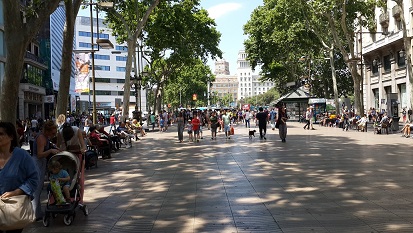Catalonia Independence Vote October 1st
The Spanish government refuses to listen to anything from Catalonia and announced it would intervene in Catalonia’s finances to ensure that “not one euro” of public money was used to fund the “illegal” vote. Meanwhile, the Spanish police arrested 13 people in the region of Catalonia and Madrid for their alleged involvement in planning a vote to secede from Spain. This is clearly demonstrating that the Spanish government is reverting to its old fascist ways for it is the boldest move yet by Spanish authorities to stop the separatist movement.
It was 1931 when the nations defaulted on their debts that saw Estat Català and other parties began to form Esquerra Republicana de Catalunya (Republican Left of Catalonia)(ERC). The ERC won a dramatic victory in the municipal elections that year and this is when we must regard the first major step in the separatics movement.
Francesc Macià founded Estat Català (Catalan State) and proclaimed the Catalan Republic. However, after negotiations with the leaders of the new Spanish Republic, he instead accepted autonomy within the Spanish state. In the Spanish Civil War, General Francisco Franco abolished Catalan autonomy in 1938. Following Franco’s death in 1975, Catalan political parties concentrated on autonomy rather than independence.
To put this in context, it was 1931 which gave birth to the Second Republic of Spain on April 14th, 1931 after the departure from Spain of King Alfonso XIII, following local and municipal elections where republican candidates won the majority of votes in urban areas. Though Alfonso did not formally abdicate, his departure from the country led to a provisional government under Niceto Alcalá Zamora. It was at this time that a constitution was drawn up.
The Second Republic of Spain in 1931 raised the hopes for the Spanish people that the middle and lower classes would be allowed to at last advance. This included at the time women rights and for the curtailment of special privileges for the Church. It was Spain’s attempt to establish a non-religious basis for national culture and citizenship.
Nonetheless, there was the largest working-class party that was the Socialists. Their principal goal was Marxist-inspired economic and social change, but they strongly favored a republic. The situation changed dramatically on May 10, 1931, as a result of the “Burning of Convents”. The provisional government of the Second Spanish Republic had little interest in restraining manifestations of anticlericalism, as became apparent shortly after the proclamation of the Republic. Many of the new political leaders were openly anti-Catholic. So we had at this time a growing Marxist movement in Spain as well. Then on May 10th, 1931, the playing of the monarchist anthem or hymn at a royalist club in Madrid provoked an attack by supporters of the Republic that soon degenerated into three days of violence directed primarily against churches, convents and monasteries. Rioting soon spread from Madrid to Seville, Malaga and four other cities. The government at first did nothing to quell the growing violence. This fragmentation would lay the foundation for the rise of Franco and the Civil War.
The Spanish Constitution of 1931 was approved by the Constituent Assembly on December 9th, 1931. It remained in force only until April 1st, 1939. This was the second period of Spanish history in which both head of state and head of government were democratically elected.
The planned referendum will take place on October 1st. Madrid refuses to address any issues despite the Catalan President and the mayor of Barcelona appealing for an agreement on a vote and issuing “a new call to dialogue” without preconditions. The 1931 movement for independence was the watershed moment. Cyclically, this is now 86 years in 2017. There is no question that independence will eventually succeed, but this is also coming at a critical time to try to save the EU. Cyclically, this is simply right on time 2017.
A comment from a reader in Barcelona says it all how memories still run deep:

